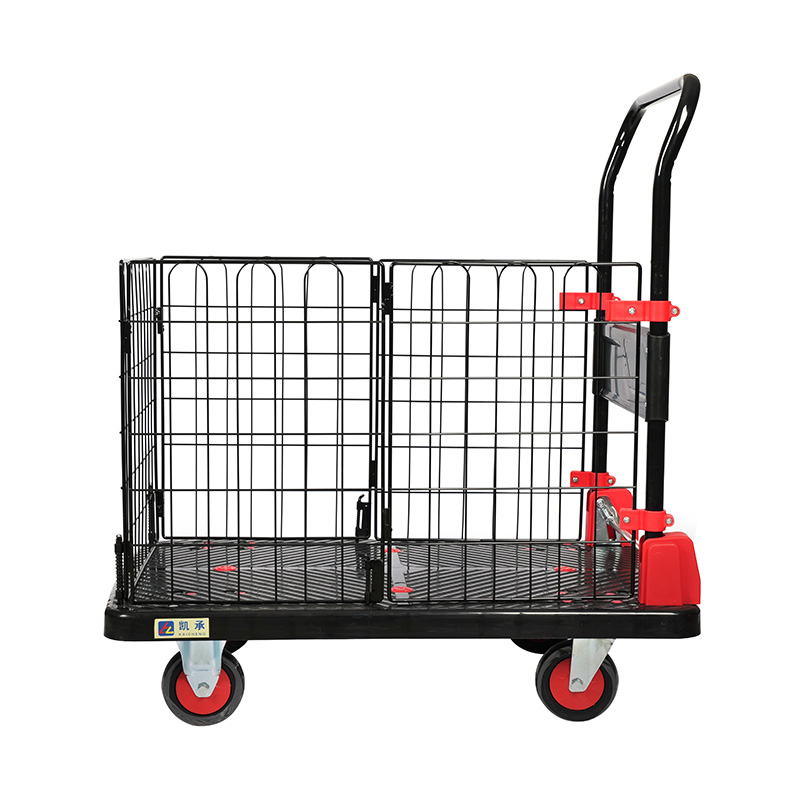Foldable trolleys have become essential tools for both home and commercial use. They help move goods efficiently, reduce physical strain, and provide a versatile solution for a variety of transport needs. Among them, metal foldable trolleys stand out for their durability and strength.
1. Understanding Metal Foldable Trolleys
A metal foldable trolley is a wheeled cart constructed primarily from metal, such as steel or aluminum, and designed to be collapsible for easy storage. Key features include:
Sturdy Frame: The metal construction ensures the trolley can support heavier loads compared to plastic alternatives.
Wheels and Casters: High-quality wheels allow smooth movement even under heavy weight.
Foldable Design: The collapsible frame makes storage convenient and transport flexible.
Handles: Ergonomic handles allow users to push or pull the trolley comfortably.
These characteristics make metal foldable trolleys practical for both domestic and commercial applications.
2. Load Capacity
One of the main factors determining whether a metal foldable trolley can carry heavy objects is its load capacity. Most trolleys specify the maximum weight they can safely handle. Typical capacities range from 100 kg (220 lbs) to 250 kg (550 lbs) or more for industrial models.
Light to Medium Loads (100–150 kg): Suitable for household use, groceries, small appliances, or office supplies.
Heavy Loads (150–250 kg): Suitable for warehouse tasks, industrial items, or bulk goods.
Exceeding the recommended weight can compromise safety, damage the trolley, or cause injury, so it is crucial to follow the manufacturer’s specifications.
3. Material Strength
Metal trolleys are generally stronger than plastic or wooden alternatives, which makes them ideal for heavy-duty applications.
Steel Trolleys: Known for high strength and durability. Steel trolleys can handle rough usage, resist bending, and endure repeated heavy loads.
Aluminum Trolleys: Lighter than steel but still strong. They are suitable for moderately heavy items while being easier to carry when folded.
The choice of metal affects both the trolley’s weight and its load-bearing capacity. Steel is heavier but stronger, whereas aluminum is lighter and more portable but may have slightly lower weight limits.
4. Wheel and Axle Design
The ability to transport heavy objects safely also depends on the trolley’s wheels and axles:
Material: Rubber or polyurethane wheels provide traction and stability. Metal or reinforced wheels are better for very heavy loads.
Diameter: Larger wheels roll more smoothly over uneven surfaces and reduce the effort needed to push or pull heavy loads.
Swivel vs Fixed Wheels: Swivel wheels improve maneuverability, while fixed wheels provide stability under weight. Some trolleys combine both for optimal control.
High-quality wheels and reinforced axles prevent deformation or wobbling when carrying heavy items, improving safety and ease of use.

5. Folding Mechanism and Safety
Foldable trolleys must maintain structural integrity even with collapsible frames. Modern designs use locking mechanisms or reinforced hinges to ensure the trolley does not collapse under heavy weight. Always check that:
The trolley locks securely in the open position.
Hinges and joints are reinforced for heavy-duty use.
Folding and unfolding mechanisms operate smoothly without excessive force.
These features are crucial to prevent accidents during transport.
6. Suitable Applications for Heavy Loads
Metal foldable trolleys are versatile and can handle a variety of heavy transport tasks:
Warehouses and Factories: Moving boxes, tools, or equipment efficiently.
Retail Stores: Stocking shelves or transporting merchandise.
Events and Catering: Carrying tables, chairs, or bulk supplies.
Home Use: Moving appliances, furniture, or gardening equipment.
By choosing the correct trolley model and respecting weight limits, users can safely and efficiently transport heavy objects.
7. Tips for Safely Transporting Heavy Objects
To maximize safety and efficiency:
Check Weight Limits – Always stay within the manufacturer’s recommended load capacity.
Distribute Weight Evenly – Place heavier items at the bottom to improve stability.
Use Straps or Bungee Cords – Secure objects to prevent shifting during movement.
Inspect Wheels and Frame – Regularly check for wear, damage, or loose screws.
Move Slowly on Uneven Surfaces – Avoid tipping or putting excessive stress on one side.
Following these tips reduces risk and ensures the trolley performs optimally.
8. Limitations
Even sturdy metal foldable trolleys have limitations:
Extremely Heavy Loads: Very large industrial machinery may exceed the trolley’s capacity.
Rough Terrain: Some trolleys perform poorly on gravel, sand, or stairs.
Space Constraints: Folding trolleys require some clearance for operation and storage.
Choosing the right trolley model for your specific needs is essential to avoid these limitations.
So, is the metal foldable trolley suitable for transporting heavy objects? The answer is yes, when used correctly. With a sturdy metal frame, reinforced wheels, and proper load distribution, these trolleys can safely and efficiently handle heavy loads in a variety of settings—from home and retail to industrial environments.
By respecting weight limits, securing items, and using proper techniques, users can maximize both safety and productivity. For anyone looking to move heavy objects without physical strain, a metal foldable trolley is a reliable, versatile, and practical solution.


 English
English Español
Español



